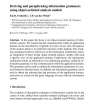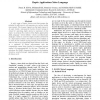1826 search results - page 125 / 366 » Using Random Forests in the Structured Language Model |
SPEECH
1998
14 years 9 months ago
1998
We consider the problem of obtaining a reduced dimension representation of electropalatographic (EPG) data. An unsupervised learning approach based on latent variable modelling is...
ACTA
2002
14 years 9 months ago
2002
Abstract. In this paper the focus is on object-oriented analysis of information systems. We assume that the communication within an application domain can be described by a logbook...
DSRT
2006
IEEE
15 years 3 months ago
2006
IEEE
A wide range of haptic devices exist that possess the potential to offer users a rich experience in a virtual reality environment. This however depends on the haptic device to be ...
108
click to vote
NAACL
2004
14 years 11 months ago
2004
The regular occurrence of disfluencies is a distinguishing characteristic of spontaneous speech. Detecting and removing such disfluencies can substantially improve the usefulness ...
ICSE
2004
IEEE-ACM
15 years 10 months ago
2004
IEEE-ACM
SLAng is an XML language for defining service level agreements, the part of a contract between the client and provider of an Internet service that describes the quality attributes...


